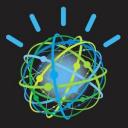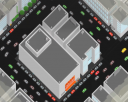Is the Smarter Planet Design Pattern on the Rise?
 IBM has a vision for a smarter planet. The vision is rooted in taking a scientific approach to services and the emerging internet of things. The pitch is that we can instrument (slap a sensor or servo on) anything, interconnect it with everything and add intelligence.
IBM has a vision for a smarter planet. The vision is rooted in taking a scientific approach to services and the emerging internet of things. The pitch is that we can instrument (slap a sensor or servo on) anything, interconnect it with everything and add intelligence.
Instrument, interconnect and add intelligence is a design pattern that shifts the cognitive load off people, extends the intelligence of individuals and groups and can otherwise be used to a wide variety mind-optimized designs.
Applications big and small are popping up everywhere.
 For example, in my cognitive design and innovation course this summer at Northwestern, one student team is analyzing smart parking meters and spaces. Sensors are added to a meter or parking space and convey availability and location information to an application running on a server. The application combines this information with data about the location and destination of the motorist and relays the cost of open parking spaces back to motorist’s phone, GPS device or computer in real-time. The application acts as a smart parking spot locator. It lowers the cognitive load and psychological stress on the motorist big time. In congested urban areas it should also lower traffic levels (30% of drivers are circling the block looking for a spot) and improve traffic safety. For information on a large-scale pilot in San Francisco check out SF Park. A seemingly simple application of instrument, interconnect and make intelligent with real cognitive, economic, safety and environmental implications.
For example, in my cognitive design and innovation course this summer at Northwestern, one student team is analyzing smart parking meters and spaces. Sensors are added to a meter or parking space and convey availability and location information to an application running on a server. The application combines this information with data about the location and destination of the motorist and relays the cost of open parking spaces back to motorist’s phone, GPS device or computer in real-time. The application acts as a smart parking spot locator. It lowers the cognitive load and psychological stress on the motorist big time. In congested urban areas it should also lower traffic levels (30% of drivers are circling the block looking for a spot) and improve traffic safety. For information on a large-scale pilot in San Francisco check out SF Park. A seemingly simple application of instrument, interconnect and make intelligent with real cognitive, economic, safety and environmental implications.
 Another student team, this time from my leadership class at Northwestern, is investigating how to use smart tattoos to improve the management of diabetes. Collecting blood glucose levels several times a day is important for managing diabetes and avoiding longer-term complications associated with the disease. Collecting these readings using traditional methods involving a finger prick can be difficult for patients to do. The Smart Tattoo offers an alternative. The tattoo acts as a sensor that can be read using a simple light pen or similar scanning device and even a cell phone. Check out how the smart tattoo team at Northeastern University is using an iPhone to get blood glucose readings.
Another student team, this time from my leadership class at Northwestern, is investigating how to use smart tattoos to improve the management of diabetes. Collecting blood glucose levels several times a day is important for managing diabetes and avoiding longer-term complications associated with the disease. Collecting these readings using traditional methods involving a finger prick can be difficult for patients to do. The Smart Tattoo offers an alternative. The tattoo acts as a sensor that can be read using a simple light pen or similar scanning device and even a cell phone. Check out how the smart tattoo team at Northeastern University is using an iPhone to get blood glucose readings.
Once captured, the information about blood glucose can be sent directly to the doctor. In theory an application on a server could collect blood glucose readings from all the patients the doctors is working with. It could send reminders to patients to scan their tattoo and rewards when they do. It could even look for patterns in the data and make recommendations to the physician for improved care. While smart tattoos are still in the developmental stage, all the other components needed to cost effectively create such a system exist today.
In this case the smart tattoo is the sensor so technically we are instrumenting a person. That will seem dehumanizing to some. Tattooing offers an interesting intermediate case between health sensors we wear and those that are directly implanted in the body. Heath sensors will play an increasing role in both the prevention and management of disease. For more information check out The Center for Body Computing.
Other examples include:
* Patients in the hospital with wristbands that are instrumented with RFID tags that convey location and condition information to an application responsible for the intelligent coordination of resources to speed up the delivery of care.
* The new vehicle-to-vehicle communication protocols that:
“… takes conventional collision-avoidance systems several steps further: it relies not just on a single set of cameras and sensors, but on an entire network of those devices attached to other vehicles, as well as stop lights, speed bumps and other elements of the traffic infrastructure. In doing so, V2V exponentially magnifies the effectiveness of the technology by getting cars to “talk” to one another and the landscape.”
Infrastructure such as V2V, smart phones, the smart grid (emerging electric energy management network) , the smart home and of course the internet, coupled with low-cost high functionality sensory and advancements in service science (not covered in this post) are enabling entirely new applications of the smarter planet design pattern. The essence of the pattern re-balances the cognitive load between people and machines to improve outcomes. It is sure to become part of every cognitive designer’s toolkit.